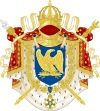Joachim Murat
| Joachim Murat | |||||
|---|---|---|---|---|---|
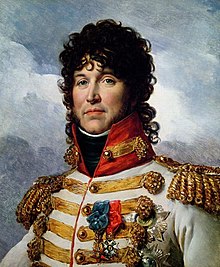 | |||||
| King of Naples | |||||
| Reign | 1 August 1808 – 19 May 1815 | ||||
| Predecessor | Joseph I | ||||
| Successor | Ferdinand IV of Naples | ||||
| Grand Duke of Berg | |||||
| Reign | 15 March 1806 – 1 August 1808 | ||||
| Successor | Louis I | ||||
| Born | Joachim Murat (1767-03-25)25 March 1767 La Bastide-Fortunière, Lot, France | ||||
| Died | 13 October 1815(1815-10-13) (aged 48) Pizzo Calabro, Calabria, Kingdom of the Two Sicilies | ||||
| Burial | Père Lachaise Cemetery; Castello di Pizzo, Naples | ||||
| Spouse | Caroline Bonaparte | ||||
| Issue |
| ||||
| |||||
| House | Murat | ||||
| Father | Pierre Murat-Jordy | ||||
| Mother | Jeanne Loubières | ||||
| Religion | Roman Catholic | ||||
Joachim-Napoléon Murat (French pronunciation: [ʒoaʃɛ̃ napɔleɔ̃ myʁa]; born Joachim Murat; Italian: Gioacchino Napoleone Murat; German: Joachim-Napoleon Murat; 25 March 1767 – 13 October 1815) was a Marshal of France and Admiral of France under the reign of Napoleon. He was also the 1st Prince Murat, Grand Duke of Berg from 1806 to 1808, and King of Naples from 1808 to 1815. Murat received his titles in part by being Napoleon's brother-in-law through marriage to his younger sister, Caroline Bonaparte, as well as personal merit. He was noted as a daring, brave, and charismatic cavalry officer as well as a flamboyant dresser, for which he was known as "the Dandy King".
Contents
1 Early life
2 French Revolutionary Wars
2.1 13 Vendémiaire
2.2 Italian and Egyptian campaigns
3 Napoleonic wars
4 Death
5 Coats of arms
6 Titles and styles
7 Children
8 Relatives
9 Footnotes
10 References
11 Further reading
12 External links
Early life
Joachim Murat was born on 25 March 1767 in La Bastide-Fortunière,[1] (renamed Labastide-Murat after its renowned citizen), in Guyenne (present-day Lot department of France) to Pierre Murat-Jordy, (d. 27 July 1799), an affluent farmer and an innkeeper,[2] and his wife Jeanne Loubières (La Bastide Fortunière, b. 1722 – La Bastide Fortunière, d. 11 March 1806), daughter of Pierre Loubières and of his wife Jeanne Viellescazes. Pierre Murat-Jordy was the son of Guillaume Murat (1692–1754) and his wife Marguerite Herbeil (d. 1755); paternal grandson of Pierre Murat, born in 1634, and wife Catherine Badourès, who died in 1697; and maternal grandson of Bertrand Herbeil and wife Anne Roques.
Joachim Murat's parents intended that he pursue a career in the church, and he was taught by the parish priest, after which he won a place at the College of Saint-Michel at Cahors when he was ten years old. He then entered seminary of the Lazarists at Toulouse, but when a regiment of cavalry passed through the city in 1787, he ran away from seminary and enlisted on 23 February 1787 in the Chasseurs des Ardennes, which the following year became known as the Chasseurs de Champagne, also known as the 12th Chasseurs. In 1789, an affair forced him to resign, and he returned to his family, becoming a clerk to a haberdasher at Saint-Ceré.[3]
French Revolutionary Wars

Joachim Murat as a sous-lieutenant of the 12th Chasseur-à-cheval; portrait by Jean-Baptiste Paulin Guérin
By 1790, he had joined the National Guard, and when the Fête of the Nation was organized on 14 July 1790, the Canton of Montaucon sent Murat as its representative. Then he became reinstated into his old regiment. Part of the 12th Chasseurs had been sent to Montmédy to protect the royal family on its flight to Varennes, meaning regiment had to defend its honor and loyalty to the Republic; Murat and the regiment's adjutant made a speech to the assembly at Toul to that effect.[4] In 1792, he joined the Constitutional Guard, but left it that same year; his departure was attributed to various causes, including his constant quarreling and dueling, although he claimed he left to avoid punishment for being absent without leave.[5]
An ardent Republican, Murat wrote to his brother in 1791 stating he was preoccupied with revolutionary affairs and would sooner die than cease to be a patriot. Upon his departure from the Constitutional Guard, he reported to the Committee of Surveillance of the Constitutional Assembly that the Guard was guilty of treason and that his Lieutenant Colonel, a man named Descours, had encouraged him to serve in the émigré army of Louis Joseph, Prince of Condé, then stationed in Koblenz.[6] This garnered for him the support of the Republicans, for he rejoined his former regiment and was promoted to Corporal in April of that year, and to Sergeant in May.[7] By 19 November 1792, he was 25 years old and elated at his latest promotion. As a sous-lieutenant, he thought, his family must recognize that he had no great tendency for the priesthood, and he was hoping to prove that he had not been wrong in wishing to be a soldier. One of the Ministers had accused him of being an aristocrat, confusing him with the noble family of Murat d'Auvergne, an accusation that continued to haunt him for the next several years.[8]
13 Vendémiaire
In the autumn of 1795, three years after King Louis XVI of France was deposed, royalist and counter-revolutionaries organised an armed uprising. On 3 October, General Napoleon Bonaparte, who was stationed in Paris, was named commander of the French National Convention's defending forces. This constitutional convention, after a long period of emergency rule, was striving to establish a more stable and permanent government in the uncertain period after the Reign of Terror. Bonaparte tasked Murat with the gathering of artillery from a suburb outside the control of the government's forces. Murat managed to take the cannons of the Camp des Sablons and transport them to the centre of Paris while avoiding the rioters. The use of these cannons – the famous "whiff of grapeshot" – on 5 October allowed Bonaparte to save the members of the National Convention.[9] For this success, Joachim Murat was made chef de brigade (colonel) and thereafter remained one of Napoleon's best officers.
Italian and Egyptian campaigns

General Murat at the battle of Abukir, where 4,000 Ottoman soldiers drowned in the Nile
In 1796, with the situation in the capital and government apparently stabilised and the war going poorly (See also: French Revolutionary Wars), Napoleon lobbied to join the armies attempting to secure the revolution against the invading monarchist forces. Murat then went with Bonaparte to northern Italy, initially as his aide-de-camp, and was later named commander of the cavalry during the many campaigns against the Austrians and their allies. These forces were waging war on France and seeking to restore a monarchy in revolutionary France. His valour and his daring cavalry charges later earned him the rank of général in these important campaigns, the battles of which became famous as Bonaparte constantly used speed of maneuver to fend off and eventually defeat individually superior opposing armies closing in on the French forces from several directions. Thus, Murat's skills in no small part helped establish Bonaparte's legendary fame and enhance his popularity with the French people.
Murat commanded the cavalry of the French Egyptian expedition of 1798, again under Bonaparte. In the 1799, some remaining staff officers, including Murat, and Bonaparte returned to France, eluding various British fleets in five frigates. A short while later, Murat played an important, even pivotal, role in Bonaparte's "coup within a coup" of 18 Brumaire (9 November 1799), when Napoleon first assumed national power. Along with two others (including Director Abbé Sieyès), Napoleon Bonaparte set aside the five-man directory government, establishing the three-man French Consulate government.

Marriage certificate of Joachim Murat and Caroline Bonaparte. Archives nationales
Murat married Caroline Bonaparte in a civil ceremony on 20 January 1800 at Mortefontaine and religiously on 4 January 1802 in Paris, thus becoming a son-in-law of Letizia Ramolino as well as brother-in-law to Joseph Bonaparte, Napoleon I of France, Lucien Bonaparte, Elisa Bonaparte, Louis Bonaparte, Pauline Bonaparte and Jérôme Bonaparte.
Napoleonic wars
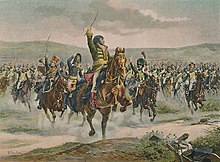
Murat leads a charge at the Battle of Jena, 14 October 1806.
Napoleon made Murat a Marshal of France on 18 May 1804, and also granted him the title of "First Horseman of Europe". He was created Prince of the Empire in 1805, appointed Grand Duke of Berg and Cleves on 15 March 1806 and held this title until 1 August 1808, when he was named King of Naples. He was in charge of the French Army in Madrid when the popular 2 May uprising that started the Peninsular War broke out.
Murat was equally useful in Russian Campaign of 1812 and during the German Campaign of 1813 in the Battle of Leipzig. However, after France's defeat at Leipzig, Murat reached an agreement with the Austrian Empire in order to save his own throne.
During the Hundred Days, he realized that the European powers, meeting as the Congress of Vienna, had the intention to remove him and return the Kingdoms of Naples to their pre-Napoleonic rulers. Murat deserted his new allies before the War of the Seventh Coalition and, after issuing a proclamation to the Italian patriots in Rimini, moved north to fight against the Austrians in the Neapolitan War to strengthen his rule in Italy by military means. He was defeated by Frederick Bianchi, a general of Francis I of Austria, in the Battle of Tolentino (2–3 May 1815).
Death
Murat fled to Corsica after Napoleon's fall. Joined by around a thousand followers, he hoped to regain control of Naples by fomenting an insurrection in Calabria. Arriving at the port of Pizzo, Murat attempted to rally support in the town square, but his plan turned awry. The crowd was hostile and he was attacked by an old woman blaming him for the loss of her son. Calabria had been badly hit by Murat's repression of local piracy and brigandage during his reign.
Soon he was captured by forces of King Ferdinand IV of Naples. He was imprisoned in the Castello di Pizzo, a small castle in the harbor of Pizzo, from where he wrote several letters, especially to his family. He was tried for treason and sentenced to death by firing squad.
On 13 October, King Ferdinand, under the advice of the British ambassador, issued a decree by which "the condemned shall be granted only half an hour to receive the aid of religion."
When the fatal moment arrived, Murat walked with a firm step to the place of execution, as calm, as unmoved, as if he had been going to an ordinary review. He would not accept a chair, nor suffer his eyes to be bound. Before his death, he said; "I have braved death too often to fear it." He stood upright, proudly and undauntedly, with his countenance towards the soldiers; and when all was ready, he kissed a cameo on which the head of his wife was engraved, and gave the word — thus,
« Soldats! Faites votre devoir ! Droit au cœur mais épargnez le visage. Feu ! »
"Soldiers! Do your duty! Straight to the heart but spare the face. Fire!"[10]
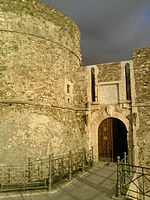
Pizzo Calabro Castle, Murat's imprisonment and execution place.
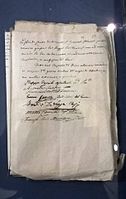
Murat's death sentence, shown in Naples State Archive.

Murat met death fearlessly, taking the shots standing and un-blindfolded.
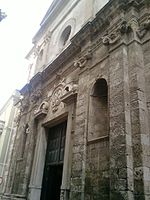
St.George's Church in Pizzo Calabro, Murat's burial place.
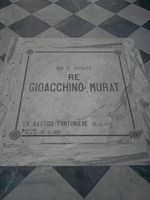
The gravestone in the centre of the nave in St.George's Church in Pizzo Calabro honouring Joachim Murat's burial place.
- Portraits of Joachim Murat

Murat in French uniform

Murat in hussar uniform and a black page.

Murat in Polish uniform.

Murat as a Marshal of the Empire.

Joachim Murat entering Florence, 19 January 1801

Murat as King of Naples.
Coats of arms

Coat of arms as Grand Duke of Berg.

Coat of arms as King of Naples.
Titles and styles
25 March 1767 – 1 February 1805: Mr Joachim Murat
1 February 1805 – 15 March 1806: His Imperial Highness Joachim-Napoleon, French Prince
15 March 1806 – 12 July 1806: Duke of Berg
12 July 1806 – 1 Aug 1808: Grand Duke of Berg and Cleves
1 August 1808 – 19 May 1815: His Majesty, by the Grace of God and the Constitution of the State, King of Naples
Children
Murat and Caroline had four children:
Achille Charles Louis Napoléon Murat, Hereditary Prince of Berg, Prince of Naples, 2nd Prince Murat (Paris, 21 January 1801 – Jefferson County, Florida, 15 April 1847), m. Tallahassee, Florida, 12 July 1826 Catherine Daingerfield Willis (near Fredericksburg, Virginia, 17 August 1803 – Tallahassee, Florida, 7 August 1867), daughter of Colonel Byrd C. Willis (29 August 1781 – 1846) and wife Mary Lewis, and great-grandniece of George Washington, without issue.
Princess Marie Letizia Josephine Annonciade Murat (Paris, 26 April 1802 – Bologna, 12 March 1859), m. Venice, 27 October 1823 Guido Taddeo Pepoli, Marchese Pepoli, Conte di Castiglione (Bologna, 7 September 1789 – Bologna, 2 March 1852), and had issue.
Lucien Charles Joseph Napoléon Murat, 2nd Sovereign Prince of Pontecorvo, 3rd Prince Murat (Milan, 16 May 1803 – Paris, 10 April 1878), m. Bordentown, New Jersey, 18 August 1831 Caroline Georgina Fraser (Charleston, South Carolina, 13 April 1810 – Paris, 10 February 1879), daughter of Thomas Fraser and wife Anne Lauton, and had issue; he was an associate of his first cousin Napoleon III of France. Ancestor of René Auberjonois.- Princess Louise Julie Caroline Murat (Paris, 21 March 1805 – Ravenna, 1 December 1889), m. Trieste, 25 October 1825 Giulio Conte Rasponi (Ravenna, 19 February 1787 – Florence, 19 July 1876) and had issue.
Relatives
He had a brother named Pierre Murat (La Bastide-Fortunière, 27 November 1748 – La Bastide-Fortunière, 8 October 1792), who married at La Bastide-Fortunière on 26 February 1783 Louise d'Astorg (La Bastide-Fortunière, 23 October 1762 – 31 May 1832), daughter of Aymeric d'Astorg, born in 1721, and wife Marie Alanyou, paternal granddaughter of Antoine d'Astorg, born 18 November 1676, and wife Marie de Mary (4 May 1686 – 7 October 1727) and maternal granddaughter of Jean Alanyou and wife Louise de Valon.
His other brother named André Murat (1760–1841) was created 1st Count Murat in 1810.
Pierre and Louise were the parents of Marie Louise, Pierre Adrien (d.1805), Marie Radegonde (d.1800), Thomas Joachim and Marie Antoinette Murat, whom Emperor Napoleon I arranged to marry Charles, Prince of Hohenzollern-Sigmaringen; Karl III and Marie were the parents of Charles Anthony, Prince of Hohenzollern from whom descended Stephanie of Hohenzollern-Sigmaringen Queen of Portugal; her brother Carol I of Romania and Carol I nephew Albert I of Belgium.
Another descendant of note is his great-great-great-grandson, the American actor René Auberjonois.
Footnotes
^ Chavanon, Jules and Georges Saint-Yves, Joachim Murat (1767–1815), (Libraire Hachette, 1905), 4.
^ Ramsey Weston Phipps. Armies of the First French Republic. London: Greenwood Publishers, 1926, vol. 1, pp. 146–47.
^ Phipps, p. 146
^ Phipps, p. 146.
^ Phipps, p. 147.
^ Phipps, p. 147.
^ Phipps, p. 147.
^ Phipps, pp. 148–49.
^ Connelly, pp. 20–21.
^ Murat, Caroline (1910). My Memoirs. London. p. 23..mw-parser-output cite.citation{font-style:inherit}.mw-parser-output .citation q{quotes:"""""""'""'"}.mw-parser-output .citation .cs1-lock-free a{background:url("//upload.wikimedia.org/wikipedia/commons/thumb/6/65/Lock-green.svg/9px-Lock-green.svg.png")no-repeat;background-position:right .1em center}.mw-parser-output .citation .cs1-lock-limited a,.mw-parser-output .citation .cs1-lock-registration a{background:url("//upload.wikimedia.org/wikipedia/commons/thumb/d/d6/Lock-gray-alt-2.svg/9px-Lock-gray-alt-2.svg.png")no-repeat;background-position:right .1em center}.mw-parser-output .citation .cs1-lock-subscription a{background:url("//upload.wikimedia.org/wikipedia/commons/thumb/a/aa/Lock-red-alt-2.svg/9px-Lock-red-alt-2.svg.png")no-repeat;background-position:right .1em center}.mw-parser-output .cs1-subscription,.mw-parser-output .cs1-registration{color:#555}.mw-parser-output .cs1-subscription span,.mw-parser-output .cs1-registration span{border-bottom:1px dotted;cursor:help}.mw-parser-output .cs1-ws-icon a{background:url("//upload.wikimedia.org/wikipedia/commons/thumb/4/4c/Wikisource-logo.svg/12px-Wikisource-logo.svg.png")no-repeat;background-position:right .1em center}.mw-parser-output code.cs1-code{color:inherit;background:inherit;border:inherit;padding:inherit}.mw-parser-output .cs1-hidden-error{display:none;font-size:100%}.mw-parser-output .cs1-visible-error{font-size:100%}.mw-parser-output .cs1-maint{display:none;color:#33aa33;margin-left:0.3em}.mw-parser-output .cs1-subscription,.mw-parser-output .cs1-registration,.mw-parser-output .cs1-format{font-size:95%}.mw-parser-output .cs1-kern-left,.mw-parser-output .cs1-kern-wl-left{padding-left:0.2em}.mw-parser-output .cs1-kern-right,.mw-parser-output .cs1-kern-wl-right{padding-right:0.2em}
References
- Bonar, Hugh S. (Jr.), Joachim Murat : lieutenant of the Emperor, Consortium on Revolutionary Europe 1750–1850 (University of Florida), Articles relatifs totalement ou partiellement à la période 1795–1815, Proceedings 1989.
- Chavanon, Jules and Georges Saint-Yves, Joachim Murat (1767–1815), Libraire Hachette, 1905.
- Connelly, Owen, Blundering to Glory: Napoleon's Military Campaigns, Scholarly Resources Imprint, 1987.
Phipps, Ramsey Weston. Armies of the First French Republic. London: Greenwood Publishers, 1926, vol. 1.
Further reading
- Potocka-Wąsowiczowa, Anna z Tyszkiewiczów. Wspomnienia naocznego świadka. Warszawa: Państwowy Instytut Wydawniczy, 1965.
External links
| Wikimedia Commons has media related to Joachim Murat. |
- Napoleonic Literature
- "Murat," in Naples Encyclopedia.
- Friends of the Musée Murat
- Map of Battle of Valutina Gora (Valutino, Loubino) 1812: Murat and Ney vs Russians
Joachim Murat House of Murat Born: 25 March 1767 Died: 13 October 1815 | ||
| Regnal titles | ||
|---|---|---|
New title | Grand Duke of Berg 15 Mar 1806 – 1 Aug 1808 | Succeeded by Louis I |
| Preceded by Joseph I | King of Naples 1 Aug 1808 – 19 May 1815 | Succeeded by Ferdinand IV |
French nobility of the First French Empire | ||
New title | Prince Murat | Succeeded by Achille Murat |













